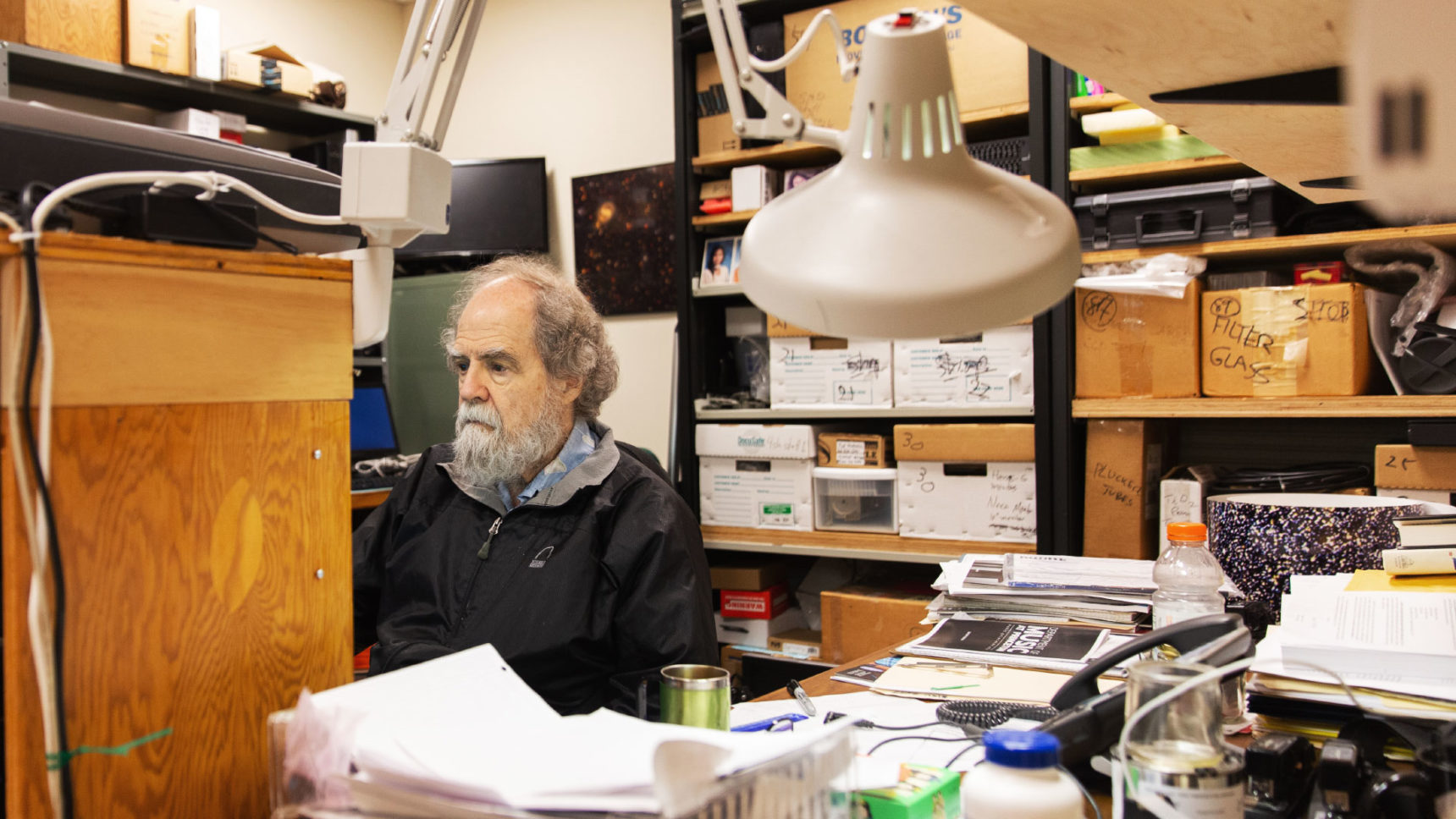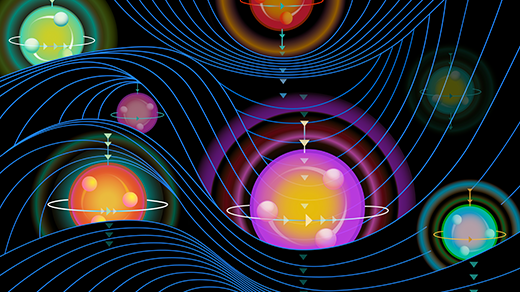The Astronomer Who’d Rather Build Space Cameras
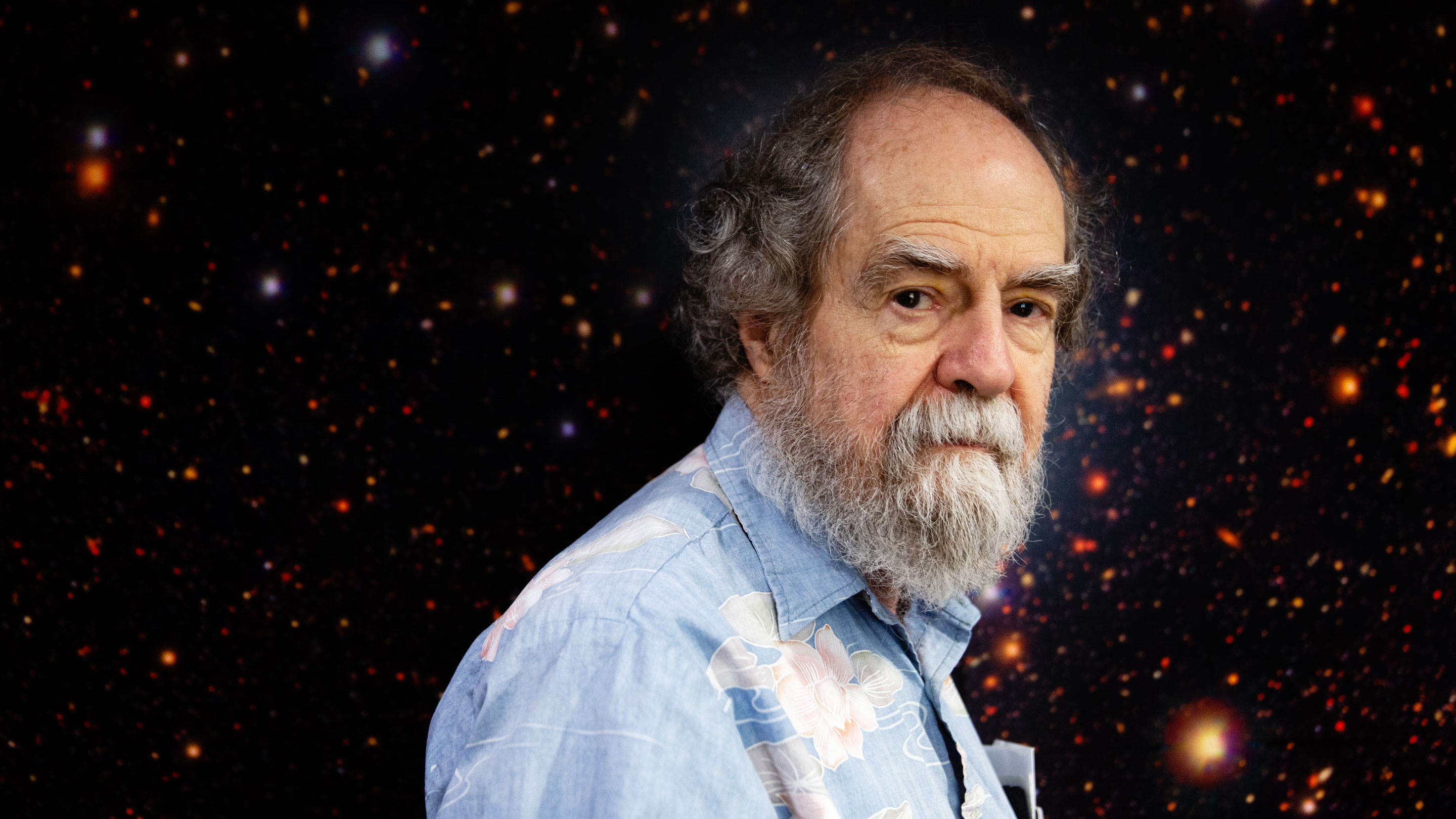
Jim Gunn at Princeton University, in front of a mosaic of images of several hundred thousand galaxies taken by the Subaru Telescope, for which Gunn is currently building a new spectrograph.
Mengwen Cao for Quanta Magazine
Introduction
In 1965, when James Edward Gunn was in graduate school at the California Institute of Technology, he figured out a way to tell when the universe first lit up with stars. Other astronomers had spotted strange sources of radio waves known as quasars at enormous distances — two-thirds of the way back to the universe’s beginning. Gunn and a fellow graduate student, Bruce Peterson, noticed that the light from these quasars was missing a signature of neutral hydrogen, meaning the hydrogen gas surrounding the objects must have been ionized by starlight. So, Gunn and Peterson argued, stars had formed by then.
The signature of neutral hydrogen from the time before stars, known as the Gunn-Peterson effect, was finally seen in 2001, in a faraway quasar that flared up when the universe was just shy of a billion years old. The quasar’s discovery established a critical transition point on the cryptic timeline of the early universe. The quasar turned up in the Sloan Digital Sky Survey, an unprecedentedly thorough and detailed catalog of the cosmos done with astronomical instruments that Gunn himself had principally designed and built.
Astronomers usually choose one of three paths: theory, observation or instrument building. Gunn, 80, the Eugene Higgins Professor Emeritus of Astrophysical Sciences at Princeton University, has done all three — gathering data on galaxies and clusters of galaxies (among other things), theorizing about how those structures formed and evolved (among other things) and, at the same time, designing and building instruments to extend telescopic capabilities. For his contributions to astronomy, he has won nearly every honor in the field, including the Crafoord Prize, astronomy’s version of a Nobel, plus a MacArthur Fellowship and the National Medal of Science.
Around 1980, though, Gunn gave up observing and theorizing to focus on instruments. For an astronomer of his talent and reputation, the choice was odd: Instrument builders don’t get much glory. They comprise less than 10 percent of astronomers and aren’t on the usual academic track. Despite this, progress in the field has always crucially depended on advances in instrumentation. And in recent decades, big questions about the structure and composition of the universe have called for specialized cameras and spectrographs capable of surveying large patches of the sky. Gunn wanted answers, and instruments were the sine qua non.
They are also his original love. Born in Texas during the Depression, Gunn has been cutting metal since his single-digit years. Observing and theorizing about the evolution of the cosmos are, he says, merely how he earned his “spurs” before getting to do what he wanted to do all along: build things. “I’ve been interested in building things from the year dot,” he told me.
He has built hardware for quasar and cluster surveys, the Hubble Space Telescope and the Sloan Digital Sky Survey, which produced one of the most highly used data sets in astronomy ever. He is now busy with what he considers his best instrument yet: a spectrograph to be installed on Japan’s 8.2-meter Subaru Telescope, for a survey that will help map the distribution of galaxies, dark matter and dark energy throughout the cosmos.
Because Gunn is an astronomer whom astronomy writers are advised to know, I’ve been interviewing him for about 30 years. This time, we talked in Princeton in his basement office, which has room for two chairs among the desks and benches and cases with a zillion tiny drawers full of tinier electronics. Our conversation about his life and love of astronomical instruments has been edited and condensed for clarity.
Your Princeton friend and colleague Jeremiah Ostriker says you are “UNIQUE [his caps] in having exceptional talents in all three directions” — meaning as a theorist, observer and instrument builder. Is he right?
I think it’s unusual, right. My impression is that most people who do instrumentation start out that way. And it’s common for people who start out as theorists to become either frustrated with their own abilities, or frustrated with the amount of data they need, and they become observers. And by and large, once they become observers, they don’t do much theory anymore.
But people don’t often drift over into being instrumentalists?
The problem is preparation. In physics, people are often trained to be experimental physicists, to do instruments. In astronomy, that just wasn’t the case. Astronomers were people who used instruments, but very seldom people who built them. The professors didn’t get their hands dirty.
Along with your work with Peterson, another theory paper that earned you your “spurs” was known as Gott, Gunn, Schramm and Tinsley, after its authors. Ostriker said that 1974 paper established the parameters for a model of an evolving universe and that it, like your other theory papers, is still seen as essentially correct.
What we were trying to do is gather all the evidence on this issue of the density of the universe. We were trying to assay how much matter there was — I mean, you can add up all the stars and it’s nothing — and trying to balance the fraction of stuff in clusters and the fraction of stuff outside them. And the number we came up with was, quite fortuitously, almost exactly the number that we believe today. Not quite “fortuitously”; I think we did a reasonable job.
Soon after that, you swerved into observation, starting what became a series of surveys of the sky. And, in fact, most of your work as an observer has not involved observations of individual objects, but surveys. Why is that?
The universe is basically a statistical beast. And so to understand any class of objects in the universe you have to do a survey. If you study the hell out of one cluster, you’re going to learn about it. But you’re not going to learn how it formed, because how it formed was part of some much larger statistical scenario that was forming lots of things. The same is true with galaxies, right? Every galaxy is a weird thing, and understanding it in detail does not tell you very much about galaxies. And so you had to understand the statistical universe to understand how these things form. I mean, that’s the story of astronomy.
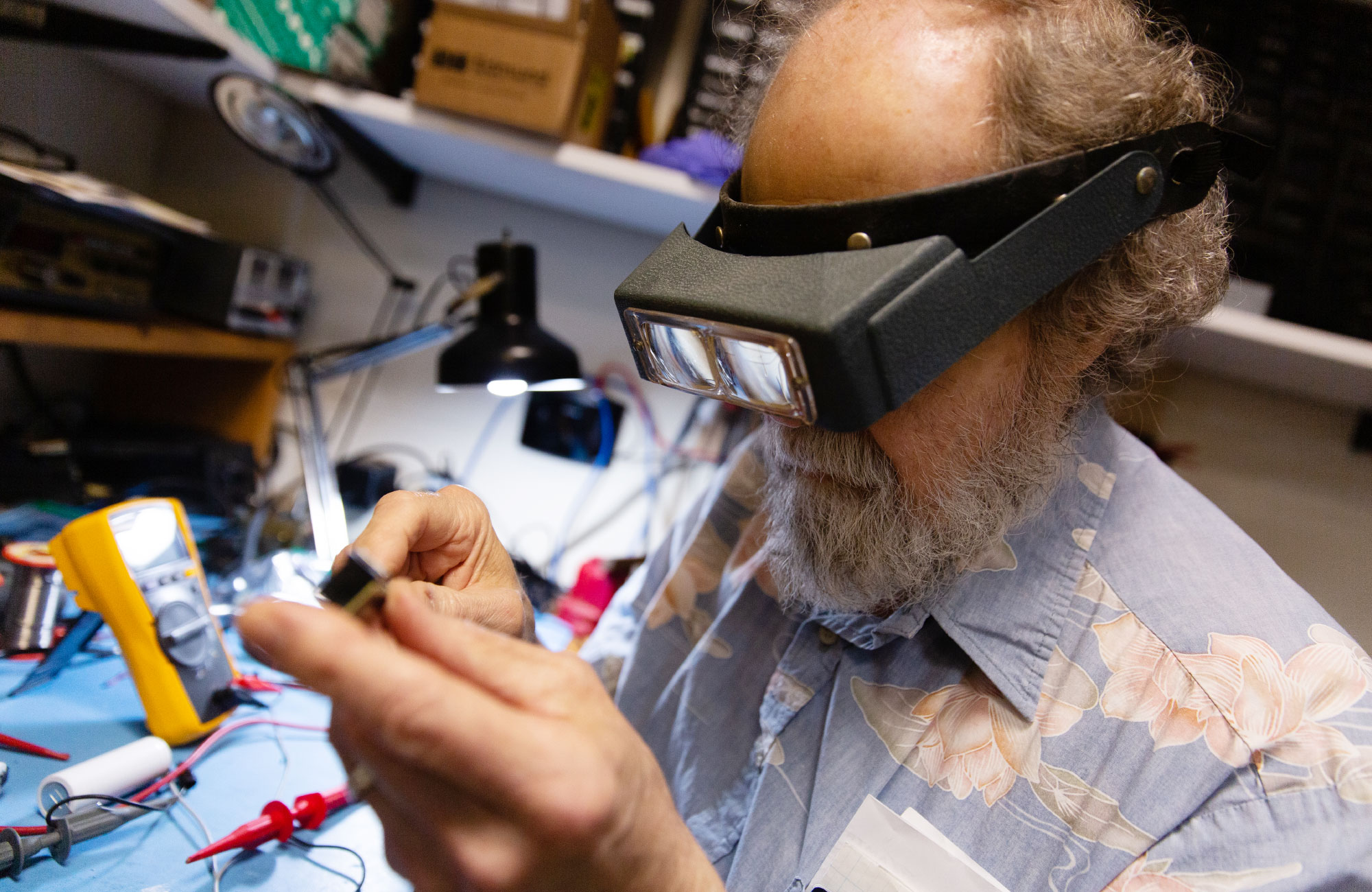
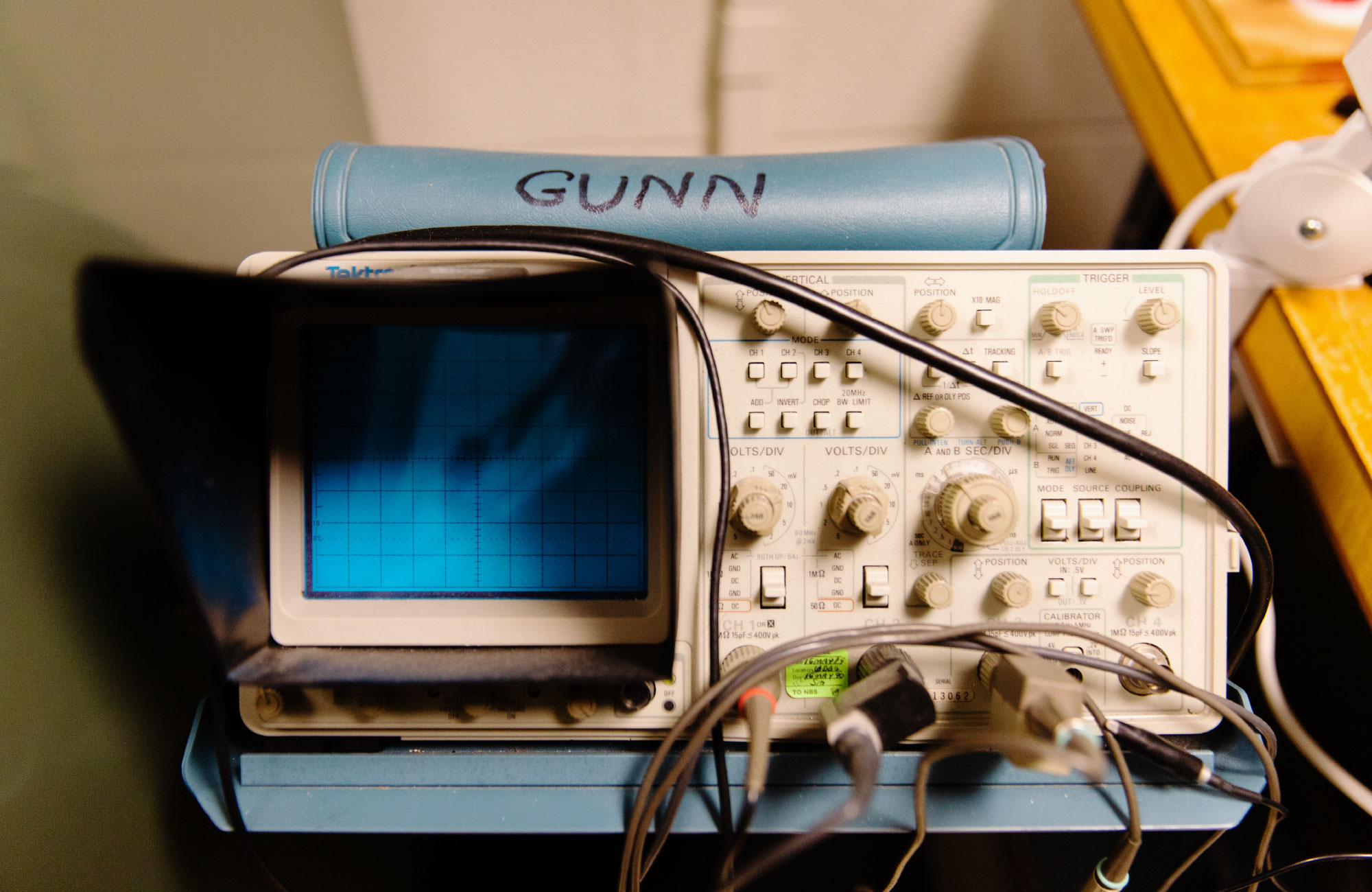
Gunn in his basement office at Princeton, surrounded by equipment.
Mengwen Cao for Quanta Magazine
So you began building the instruments to do the surveys: cameras for the brightness and shapes of things, spectrographs for their colors, which imply their distances. When did you start building instruments?
Oh, I was interested in building things from the year dot. My dad was an exploration geophysicist and he was working for Gulf Oil during the Second World War, looking for oil. We were wandering all over the country and there were machines that had to be kept up, vehicles [and] scientific instruments you couldn’t get parts for, because of the war. So we had this trailer that was a machine shop on wheels. I learned to use a lathe at the age of 7. And I was very interested in astronomy, so I started being a serious amateur astronomer and building telescopes and things. Later, after my father died and I was in high school, I built an 8-inch photographic telescope which had a transistorized electronic drive, built all the cameras, did the optics, actually. And so I knew I was going to make things from the very beginning.
After people found very distant quasars in the 1960s, you wanted to study the population of quasars. (They’re now known to be luminous material surrounding supermassive black holes.) So in the ’70s, you built one of the earliest astronomical instruments with CCDs, which had just been invented and could detect light much more sensitively than photographic plates. Could you talk about that instrument, the Prime Focus Universal Extragalactic Instrument, which you called PFUEI (pronounced “pfooey”)?
PFUEI was a funny instrument; it could be either a spectrograph or an imager. We wanted to find the earliest things in the universe and, you know, try to understand how things can form that early. So we got the quasar survey started with PFUEI.
PFUEI was quite successful. But I thought, you know, to do proper surveys of clusters we really needed a bigger instrument with a bigger field. And we had this idea for the optical layout of the WFPC [pronounced “wiffpick”].
That’s the Wide Field/Planetary Camera that was installed on the Hubble Space Telescope. How did it work?
The WFPC has this pyramid mirror that splits the field into four pieces. So you can look at the sky with four CCDs and get four times as much area. I thought that it would be a cool idea, so we proposed to NASA to build this prototype. They bought it, and so we built 4-Shooter. I think I was using PFUEI while I was designing 4-Shooter. I don’t think I’ve ever really tried to build two instruments at the same time.
The quasar survey, done with both PFUEI and 4-Shooter, found nearly 100 quasars, and established their rise and fall in the universe’s history. And then the cluster survey found clusters of galaxies close to the beginning of the universe — uncomfortably so, because cosmologists couldn’t account for how such large structures formed so early. But the surveys were completed by your colleagues, not by you, because your pattern was, you’d build one thing —
— be using it for a while, be thinking about the next thing. The seeds for Sloan were already in place before [Hubble] Space Telescope was launched. Morley Blouke, a scientist at Texas Instruments, showed up with this thing in his briefcase — the largest CCD that had ever been built. And I really got the bug for Sloan then, because I knew that this thing was going to just turn everything over.
You designed and built a wide-field CCD camera for the Sloan, plus a spectroscope that could take 640 spectra at a time. The Sloan eventually got images and spectra on 3 million objects — clusters, quasars, galaxies, stars, asteroids. Was that time well spent?
People ask what Sloan discovered. We didn’t discover any new classes of objects. We didn’t discover a single thing that was very surprising. What we did was really nail lots of things with superb data, superb statistics, so that one could understand much better what the universe is like today.
You’re now building the Prime Focus Spectrograph for a survey by the Subaru Telescope. Why did you decide to work on PFS?
Because it was the next step after Sloan, I think. The PFS is on a very big telescope so it can go deeper [into the sky] than other surveys. We’ll see the history of most of the stars in the universe. There is also no telescope in the world with a field as big as Subaru. I mean, Sloan did what it did very, very well, but you really want to open the history book a little wider, to look at how things got to be the way they are.
Subaru already has a survey camera, right — the Hyper Suprime-Cam, on which you advised? Why does it need a spectrograph?
You pick out objects on the sky from the Hyper Suprime-Cam imaging — galaxies from their shapes and quasars from their colors. Then you take a spectrum with PFS. There’s 2,400 [spectroscopic] fibers, and each one has a little machine that can move the fiber around in an area about 8 millimeters in diameter. And these machines are able to put a fiber on the object. And you say, well, that one is not quite where I want it to be, you ootch it a little bit this way, it isn’t quite right, let’s ootch a little bit that way. And all this miraculously takes about a minute. And then you take the spectrum.
That means 2,400 spectra at once. Really good spectra?
Well, I hope they’re good spectra; we ain’t there yet. Whether we’ll discover anything new? I don’t know. I think we’ll understand the universe a hell of a lot better when it’s done.
Hasn’t this switch from theory and observation to instrument building come with a cost? Once you went full time on the Sloan, what happened to your publication rate?
Oh, it tanked.
Since publications are the coin of the realm for an astronomer, do you regret that?
No. Leading a scientific effort is fun, but leading an instrument project is fun as well, and since I do the latter and don’t do the former, I guess that’s what I want to do. I’m perfectly happy doing it, anyway. I found it enormously more satisfying to do the best I could to make the survey of such high quality that other people can do good work. And so it’s a question of being a father. And I am not at all unhappy with the choice I made.
Does aesthetics play some role in all of this?
Oh, it plays an enormous role. I just like beautiful things, little beautiful things. And instruments are — the way they’re wired, the way they’re controlled, the way the optics works — they’re just beautiful. Things that are ugly don’t work very well. It’s the way the instrument is built physically. It’s the way the data come off. It’s the way the software works. And the universe itself is incredibly beautiful. I think a lot of people think that analyzing stuff takes the beauty away. And it’s just not so, it’s just not so at all. It is certainly no less beautiful for being understood — in the sense that scientists understand things, the chain of connections from fundamental physics up. It’s beautiful.
Last question: You’re 80. When you started the PFS, weren’t you already past retirement age?
Well no, I wasn’t past, but I was close to it.
But you retired late.
I retired early. I was 75. Well, retirement age is formally at 68 at this university but nobody pays any attention. I will quit when I’m no longer useful. I don’t think that’s quite happened yet.
